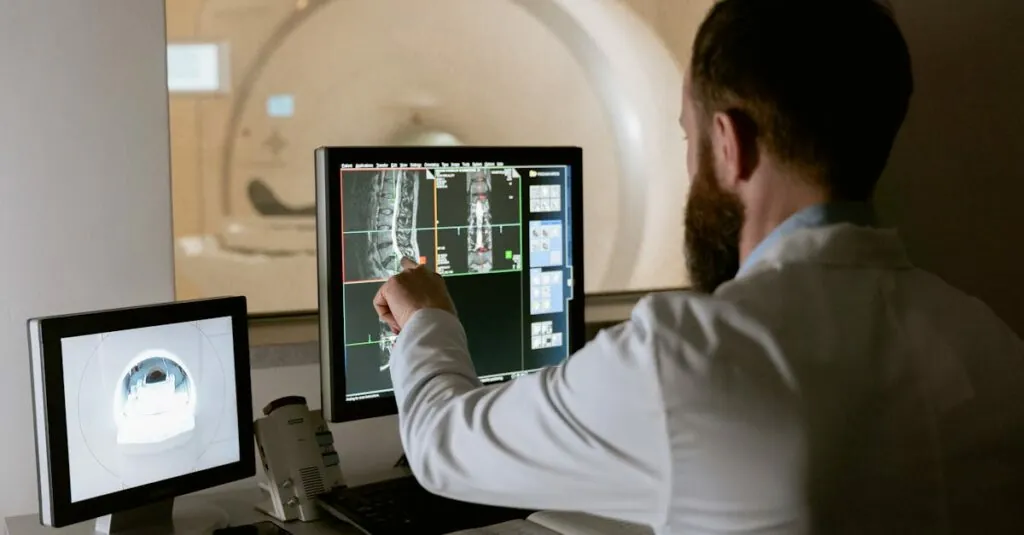When was the last time someone asked you about your bone density? If you’re like most people, that question probably hasn’t come up at the dinner table. But let’s face it: strong bones are the unsung heroes of our bodies. They support us through thick and thin—literally! A bone density test is like a superhero sidekick, swooping in to assess your bone health and help prevent future fractures.
Table of Contents
ToggleOverview of Bone Density Test
A bone density test evaluates bone strength and health. Health professionals often recommend this test, especially for individuals at risk of osteoporosis. Measurement focuses on the mineral content, specifically calcium and phosphate, within the bones.
Common testing methods include dual-energy X-ray absorptiometry (DEXA) scans. These scans provide accurate results with minimal radiation exposure. Results typically express bone density as a T-score, indicating how a person’s bone density compares to a healthy young adult’s bone density.
Individuals over 50, postmenopausal women, and those with a family history of osteoporosis often require routine testing. Doctors may also recommend testing for people taking medications affecting bone health or those experiencing fractures with minimal trauma.
Test preparation generally involves avoiding calcium supplements 24 hours prior. Patients typically wear loose clothing for convenience during scanning. The test itself takes about 10 to 30 minutes, with results usually available within a few days.
Understanding results aids in determining appropriate actions. A T-score of -1.0 or higher indicates normal bone density. Scores between -1.0 and -2.5 suggest low bone mass, while a score of -2.5 or lower indicates osteoporosis.
Diagnosis influences treatment plans, which may include lifestyle adjustments, dietary changes, or medication. Tracking bone health improves overall wellbeing and reduces fracture risk. Regular screenings contribute to proactive health management for individuals concerned about their bone density.
Importance of Bone Density Testing
Bone density testing plays a crucial role in maintaining overall bone health. Regular assessments can prevent fractures by identifying individuals at risk of osteoporosis.
Risk Factors for Osteoporosis
Family history significantly influences risk for osteoporosis. Age also affects bone density, with individuals over 50 experiencing increased vulnerability. Lifestyle habits contribute as well; smoking and excessive alcohol consumption weaken bones. Low body weight poses another threat, as does a diet lacking essential nutrients like calcium and vitamin D. Hormonal changes, particularly in postmenopausal women and individuals with low testosterone levels, elevate the risk. Chronic conditions like rheumatoid arthritis and certain medications may further decrease bone density.
Benefits of Early Detection
Detecting low bone density early enhances treatment options. It allows individuals to implement lifestyle changes, such as dietary improvements and regular exercise, aimed at strengthening bones. Early diagnosis often results in timely interventions, preventing significant fractures. Medications prescribed can effectively slow bone loss and promote new bone growth. Moreover, understanding personal risk factors guides individuals in making informed health decisions. Regular screenings ultimately support proactive health management strategies, significantly benefiting long-term well-being.
How Bone Density Tests Are Conducted
Bone density tests assess the strength and health of bones, helping detect osteoporosis and fracture risk. Commonly, these tests utilize advanced imaging techniques to ensure accuracy and comfort for patients.
Types of Bone Density Tests
Dual-energy X-ray absorptiometry (DEXA) scans represent the most common method. DEXA uses two X-ray beams to measure bone density at the hip and spine. Quantitative computed tomography (QCT) also provides a three-dimensional view, offering more detailed information about bone density. Ultrasound techniques, while less common, can measure bone density through sound waves at peripheral sites. Each type provides unique insights into skeletal health.
Preparing for the Test
Preparation for a bone density test involves simple steps to ensure accurate results. Patients should avoid calcium supplements for 24 hours prior to testing. Clothing without metal fasteners may prevent interference from zippers or buttons. Informing the technician about recent imaging tests, such as X-rays or CT scans, helps with scheduling. Individuals must also share details about their medical history and any medications taken that could affect bone density. These precautions enhance the effectiveness of the bone density assessment.
Interpreting Test Results
Interpreting bone density test results involves understanding the T-score, which provides valuable insights into bone health. A T-score of -1.0 or higher indicates normal bone density. Scores between -1.0 and -2.5 suggest low bone density, known as osteopenia. Results below -2.5 confirm osteoporosis, signaling a significant risk for fractures.
Healthcare professionals assess these scores in conjunction with individual risk factors. Age, sex, and family history play essential roles in evaluating overall bone health. A T-score’s context determines its significance more than the number indicates alone.
Recommendations for treatment arise based on the T-score and risk profile. Medications may be prescribed to slow bone loss or enhance bone growth. Lifestyle changes, such as increased calcium and vitamin D intake, can also be critical. Regular physical activity contributes positively as well, improving overall strength and balance.
Follow-up testing may be necessary to monitor changes in bone density. Costs for bone density tests fluctuate based on location and healthcare providers. Insurance often covers these necessary assessments, particularly for high-risk individuals.
Understanding test results empowers individuals to take proactive measures for their bone health. Awareness of one’s risk factors facilitates informed discussions with healthcare professionals. Together, they create effective strategies for managing bone density, potentially reducing the likelihood of fractures in the future.
Treatment Options for Low Bone Density
Healthcare providers recommend various treatment options for individuals with low bone density. Medications such as bisphosphonates, denosumab, and hormone therapy play key roles in slowing bone loss and promoting new bone formation. These treatments target specific pathways involved in bone metabolism.
Calcium and vitamin D supplementation is crucial in enhancing bone health. Increasing dietary calcium through products like dairy, leafy greens, and fortified foods supports stronger bones. Ensuring adequate vitamin D levels facilitates calcium absorption and overall bone health.
Weight-bearing and strength-training exercises significantly improve bone density. Activities such as walking, jogging, and weightlifting stimulate bone strength and promote overall fitness. Engaging in regular exercise can reduce fracture risk and enhance mobility.
Lifestyle changes can also contribute positively. Quitting smoking and limiting alcohol intake are essential steps towards better bone health. Individuals should focus on maintaining a healthy weight, as low body weight has been linked to decreased bone density.
Follow-up bone density testing is recommended to monitor treatment effectiveness. Adjustments to treatment plans may occur based on test results and individual circumstances. Regular consultations with healthcare providers allow for personalized strategies to optimize bone health.
Overall, a combination of medications, nutritional support, exercise, and lifestyle changes creates a comprehensive approach to treating low bone density. These strategies empower individuals to take control of their bone health, reducing the risk of fractures and enhancing quality of life.
Bone density tests are essential for anyone concerned about their bone health. By identifying risks early, individuals can take proactive steps to strengthen their bones and prevent fractures. Regular screenings empower people to make informed decisions about their health and lifestyle.
With advancements in testing methods like DEXA scans, assessing bone density has become more accessible and accurate. Understanding T-scores and their implications helps individuals work with healthcare providers to develop tailored treatment plans.
Incorporating medications, nutrition, and exercise into daily routines can significantly improve bone health. By prioritizing bone density testing, individuals can enhance their overall well-being and quality of life.




